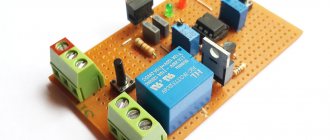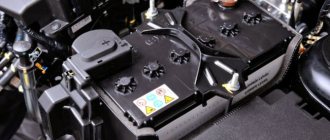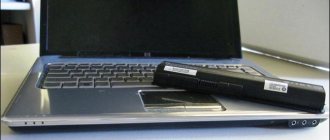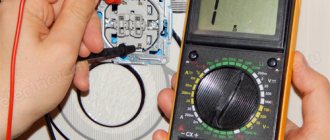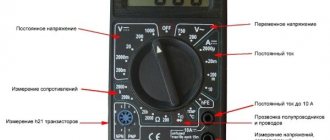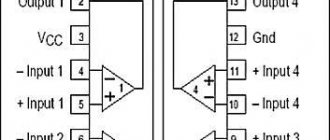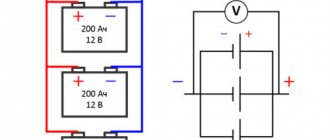Popular Graphic key - how to unlock it on Android if you forgot it
Android - what is it on a phone: Details
How to open and configure the engineering menu on Android - instructions and secret codes
Can't connect Android to WI-FI network?
“Phone memory is full” on Android: reasons and solutions
Commented by Zheim Happer 02/02/2021 18:52 Deleted Stk.apk, no problems :-)… Removing system APKs
James Happer 02/02/2021 18:50 Deleted Stk.apk, everything works as it should. I even noticed a certain article... Removing system APKs
Maksim 01/26/2021 11:50 Smart Launcher is essentially a third-party shell for Android... How to hide applications on Android
Tahir 01/23/2021 06:23 Cash. Memory... Solving the problem with files on the...
Arayka 01/17/2021 19:52 How can you hide an application in a smart launcher? You can or... How to hide applications on Android
fans-android.com › FAQ
July 03, 2015
Author: Maxim
Modern batteries remain one of the biggest challenges for both manufacturers and consumers. And the point here is not so much the potential risk of fire, but the gradual depletion of the power source itself.
Therefore, you should not be surprised that with daily charging, batteries can withstand a year or two of active use, after which their capacity drops catastrophically and using your favorite gadget becomes problematic.
It is impossible to completely revive a dead battery, but you can extend the period of active use while you are busy looking for a replacement. This is what we will talk about today.
The recommendations below are designed for a technically trained user, therefore, if you do not know which side to approach the soldering iron, it is better to either contact the services of a service center or immediately go to the store for a new battery.
Phone with modern Li-Ion battery
- 1 Method No. 1
- 2 Method No. 2 2.1 A few important notes
Method No. 1
It can help in cases where, due to prolonged operation, gases begin to accumulate inside, as a result of which the battery swells and does not hold a charge well.
Tools and materials needed: soldering iron, some epoxy resin, thin needle, flat heavy object for alignment.
- As carefully as possible, disconnect the battery case from the upper block with the sensor.
- Separate the electronic sensor.
- Under it there should be a cap, inside of which the control electronics are hidden. We carefully pierce it, for which a thin needle is well suited. Remember that if the filling is damaged, it will no longer be possible to revive the battery.
- Next, you need to roughly estimate the size of the battery and find a flat, heavy object that will be slightly larger in area.
- The most crucial moment. Place the battery on the table and press it with a press. Keep in mind: excessive force can damage the battery, while insufficient force, on the contrary, will not lead to the desired result. It is also strictly not recommended to use a vice or similar devices during repairs.
- Once everything is ready, drop some epoxy onto the hole and solder the sensor.
Tools and materials for diagnosing your phone battery
Method No. 2
It is not able to revive a battery with a significantly reduced resource, but it can extend its life a little. You shouldn’t count on much, but a reconditioned battery can provide power to a modern smartphone while you look for a replacement.
Necessary tools and materials: any power supply (5–12 V, current at least 0.1 A), voltmeter or tester for voltage control, resistor (power at least 500 mW, resistance from 330 to 1000 Ohms).
- If you don’t have a spare power supply, almost any complete one from active network equipment (switches, routers, modems) will do. You must first make sure that the parameters of the current it produces correspond to the required ones.
- We release the contacts of the power supply and connect them to the dead battery: the “minus” of the power supply with the “minus” of the battery, and add a resistor to the “positive” line. Be sure to check the correct polarity of the connection using a multimeter.
- When everything is done, connect the power supply to the network. The procedure time is no more than 2–3 minutes. If possible, monitor the process using a tester: the maximum permissible voltage is no more than 3.3 V.
A few important notes
- Do not leave a problem battery unattended during repairs. Cases of spontaneous combustion are not a theory, but a harsh reality.
- Periodically check the temperature of the “client” with a remote thermocouple, an electronic thermometer, or simply with your hand. If the surface feels hot rather than just warm, stop repairing immediately.
- Excessive charging currents should not be used. The maximum you can afford is 50 mAh. This parameter is calculated as follows: divide the power supply voltage by the resistor capacitance. For example, if the first parameter is 12 V, and the second is 500 Ohm, then the charging current will be 24 mAh.
- Instead of a resistor, you can use a standard 80mm computer fan.
- To avoid spontaneous combustion, it is also recommended to monitor the initial charging of the reconditioned battery.
Method for restoring over-discharged lithium batteries
As you know, a lithium battery is equipped with a charge/discharge controller - a miniature printed circuit board on which an electronic circuit is mounted. I have already talked about it here.
This circuit monitors the state of the lithium cell (or "jar"). If the voltage on it drops below 3.2 - 3.3V, then the protection circuit simply disconnects this “can” from the outside world. This is necessary in order to prevent deep discharge of the element and its failure.
When measuring the voltage at the battery terminals, it seems that it has become unusable. But that's not true!
If you measure the voltage on the cell before the controller, you will find that the element produces a voltage of about 2.5 - 2.7 volts. This is quite enough to “boost” the battery and bring it back to life.
Let's consider an example of restoring a Li-pol battery from a cell phone.
First, we disassemble it and disconnect the board with the protection controller. Sometimes the protection circuit is simply wrapped in transparent tape and is easily visible without disassembly.
The charge/discharge controller is slightly larger.
Unsolder the charge/discharge controller circuit board. We are left with only a 3.7-volt Li-pol battery cell.
Next we need a charger. I used the Turnigy Accucell 6 universal charger-discharge device. The advantage of this charger is that it can be used to charge unprotected (that is, without a protective controller) lithium batteries. The entire process is controlled by a microcontroller and the device itself monitors the charging process according to the standard CC/CV .
We connect the “can” to the terminals of the charger.
Next, you need to select the charging parameters. Using the “ TYPE ” button, select the Li-Po charging program since we have a 3.7V battery.
Click “ START ”. The following message will appear on the screen.
By short pressing the “ START ” button, we select the charge parameter we need - the selected one will blink. Use the “ + ” and “ - ” buttons to set the required value.
Read also: Sharpener for ceramic knives reviews
We set the charge current - better than 0.1 of the capacity ( 0.1C ). That is, if you have a battery capacity of 1500mAh, then it is better to set the current to 150mA. In the Turnigy Accucell 6 charger, the charge current setting step is 100mA, so I chose 0.2A (200mA), although you can set it to 0.1A.
Important! The charger settings are usually set to the standard battery voltage. For Li-ion it is 3.6V , and for Li-pol it is 3.7V ).
Method No. 3
The technique is controversial and dubious, but, according to reviews on specialized forums, it helps some users, so the responsibility for possible negative consequences lies with you.
Tools and materials needed: working refrigerator.
- Remove the battery that shows no signs of life from the smartphone and put it in a plastic bag, which should be placed in the freezer for 20–30 minutes.
- Next, take it out of the refrigerator, insert it into the phone and charge for about 1 minute.
- Remove it from the device, let it warm up to room temperature, and then charge it as usual.
Method No. 4
A harmless but ineffective resuscitation technique. But if you think that the battery in your smartphone has completely failed, then why not try it?
Required tools and materials: smartphone with standard charger.
- Bring the battery to full discharge (when the phone no longer turns on). Any resource-intensive game or AnTuTu utility can help with this.
- Fully charge the battery to 100%.
- Repeat steps 1 and 2 several times.
How to extend your phone's battery life?
If your device has a lithium battery, you can extend battery life with simple tips:
- Turn off mobile Internet when not needed. 4G requires a lot of energy, especially if the cellular operator's coverage has poor signal levels.
- Remove unnecessary applications. Many programs constantly run in the background, draining your battery. The user needs to check the list of applications and delete unnecessary files. As a result, the mobile device will work longer, and free memory will appear.
- Don't overheat your phone. It is not recommended to expose the gadget to direct sunlight, because it causes battery degradation. It is also undesirable to use the smartphone while charging - as a result, the case becomes very hot.
- Use quality power supplies. It is important to charge your mobile device only with certified adapters. Cheap copies may differ in characteristics, so they are harmful to the built-in battery, and sometimes cause it to catch fire.
- Do not expose your gadget to cold. Sudden temperature changes can provoke a deterioration in autonomy. In winter, it is advisable to carry the device in your inner pocket.
- Please read our instructions carefully.
( 10 ratings, average: 4.90 out of 5)
Method No. 5
Almost all professional electricians will consider the procedure below to be sacrilege, but it has helped many users of old batteries.
Important note: it is strictly not recommended to use this technique if you have not yet tried other, less risky methods.
Necessary tools and materials: razor blade, thin screwdriver, moment glue.
- We remove the battery from the phone.
- Peel off the sticker with technical characteristics.
- We cut off the top plastic cover as much as possible, behind which the control electronics are hidden.
- We find the main contacts.
- We briefly close them with any metal object.
- Glue the top cover and let it dry.
We remind you once again that none of the above methods of resuscitation guarantees a 100% result, and all responsibility falls entirely on your shoulders. But if the battery has completely turned off, and the purchase of a new one is postponed for several days, it’s worth a try. But if you rarely pick up a soldering iron and consider yourself a humanitarian, it’s better to turn to a friend who knows the subject for help.
Video instruction
tell friends
Similar posts How to charge your phone correctly: instructions
How to charge wireless headphones - correctly
AirPods: how to charge correctly and quickly
How to quickly charge your phone: all methods
Comments - 9: aleks Jan 9, 2021 at 02:10 pm
After replacement, the original laptop battery sat in the countryside in the cold and heat for 2 years, after which it began to charge again, but only to 80%. So I accidentally tested method No. 3.
Answer
Karina Shumnaya May 10, 2021 at 12:45 pm
Method 3 really helped!! Thank you very much!!!!
Answer
Patriot Patriot Apr 23, 2021 at 11:13 am
Method No. 3 helped. Freeze in the freezer for 30 minutes. etc. Thank you! The Li-Ion battery showed one percent charge and would not charge.
Answer
Anatoly Dec 22, 2021 at 14:19
1. A resistor is not a capacitor and it does not have a capacitance, but a resistance. 2. Current is measured in mA and not mAh
Answer
S. Dec 19, 2021 at 09:07
Method number 3 used to help. Last time - he doesn’t charge. Combined with the 2nd method: freezing for 1 hour (-18°C), charging from any power supply through a current-limiting resistor (for a maximum current of 50 mA), but not 1-3 minutes, but until the charging current increases to 25 mA ( it turned out to be about 10 minutes), i.e., until the acc began to confidently take charge. Then - I didn’t wait until it warmed up to room. temperature, and immediately put it on normal charging. There it stands and charges confidently. It started with 9 mA, gradually the charge current increased to 75 mA, and as it charged, it decreased. Now - 57 mA. When it drops to a few mA, I’ll take it off the charger, and then everything’s fine. The main thing is not to forget about the battery for six months, and periodically recharge it.
Answer
Elena Gorlova Oct 24, 2021 at 01:17 pm
I tried method No. 3 on an ASUS tablet, since I can’t do any other methods, I don’t understand anything about it and Ur-aaaa!!! Thanks a lot! I just didn’t take out the battery, I don’t even know where it is, I just put the tablet completely in the freezer.
Answer
Sashok Aug 26, 2021 at 09:08
According to Ohm's law, everything converges I = U / R
Answer
[email protected] Feb 8, 2021 at 09:49
“if the first parameter is 12 V, and the second is 500 Ohm, then the charging current will be 24 mAh” Do you even understand what you are writing about?
Answer
Sergey Sergey Oct 13, 2015 at 22:48
not even about anything, but about nothing! Barbie-Litvinova, go do something useful and feminine!
Answer
What is a lithium-ion battery (LIB)
What it represents, how it works, its characteristics and components - all this is important to know in order to understand the processes that arise during its operation, as well as in order to understand how to restore a lithium-ion battery.
In addition, you will learn about the causes of fire, explosion hazards, and aging of LIBs. This information will help determine what exactly happened to the battery, and will also make it possible to avoid operational errors.
Improper use may lead to explosion and fire of the gadget.
So, lithium-ion batteries (LIB) are used in a wide range of various modern technologies as a source of electricity. energy from mobile phones to storage devices in energy systems.
Read also: Manual stapler for furniture
Their main performance indicators may vary within the following limits (this depends on their chemical composition):
- Voltage (nominal) - 3.7 V or 3.8 V;
- Maximum voltage - 4.23 V or 4.4 V;
- Minimum voltage - 2.5–2.75 V or 3.0 V;
- The number of charge-discharges is 600 (with a loss of 20% of capacity);
- Internal resistance 5–15 mOhm/Ah;
- Under normal conditions, the self-discharge value is 3% per month;
- The operating temperature range is from minus 20°C to plus 60°C, the optimal temperature is plus 20°C.
- If the voltage is exceeded when charging the LIB, it may catch fire. To protect against this, a controller is inserted into the housing. Its function is to disable the LIB. (Also controlling current, overheating and depth of discharge).
- To reduce costs, not every lithium battery is equipped with a controller (or does not provide protection for all parameters).
Design and advantages of LIB
A LIB consists of a cathode (on aluminum foil) and an anode (on copper foil), separated by an electrolytic separator and placed in a sealed “can.”
The figure shows the structure of a standard lithium-ion battery
The cathode and anode are connected to the current collecting terminals.
The housing is sometimes equipped with a valve to relieve pressure in case of emergency operation.
In a lithium-ion battery (LIB), the charge is carried by a lithium ion. Its characteristic ability is the ability to penetrate into the crystal lattice of other materials (in our case, graphite, oxides or salts of metals), thereby forming chemical bonds.
Currently, three types of cathode materials are used:
- Lithium cobaltates (thanks to cobalt, the number of charge-discharge cycles increases, and it also becomes possible to operate at low temperatures);
- Lithium manganese;
- Lithium ferrophosphate (low cost).
- The advantages of LIBs are low self-discharge and a large number of cycles.
Disadvantages of LIA
The explosion hazard of Li-ion batteries in the first generation was justified by the occurrence of gaseous formations that led to a short circuit between the electrodes. This has now been eliminated by changing the anode material from lithium metal to graphite.
Battery fires were caused by the way they were assembled in the first generations.
Explosion hazards also arose in cobalt oxide LIBs due to operational failures.
LIBs based on lithium ferrophosphate are completely free of this disadvantage.
Memory effect
Research has confirmed the existence of a memory effect in LIB. But the point is its fundamental presence, and not its influence on the work as a whole.
The explanation for this process is as follows: the battery operates by periodically releasing and capturing lithium ions, and this process, when not fully charged, deteriorates due to disruption of the microstructure of the electrode.
- Preventing complete discharge;
- Do not charge near heat sources.
Aging
LIBs age even when not in use. Twenty percent of capacity is lost after just two years. You should not buy them “for the table”. When purchasing, look at the production date.
Low temperatures and power
Up to fifty percent of battery power is lost at operating temperatures below 0 °C.
When used in low temperatures, the battery discharges quickly
Spontaneous combustion
LIBs are prone to spontaneous combustion. During thermal acceleration of a faulty (damaged) battery, substances are released that accelerate its self-heating (oxygen plus flammable gases). Therefore, it is capable of burning even in the absence of air.
To extinguish in such cases, provide for a lower temperature and prevent the spread of fire.
